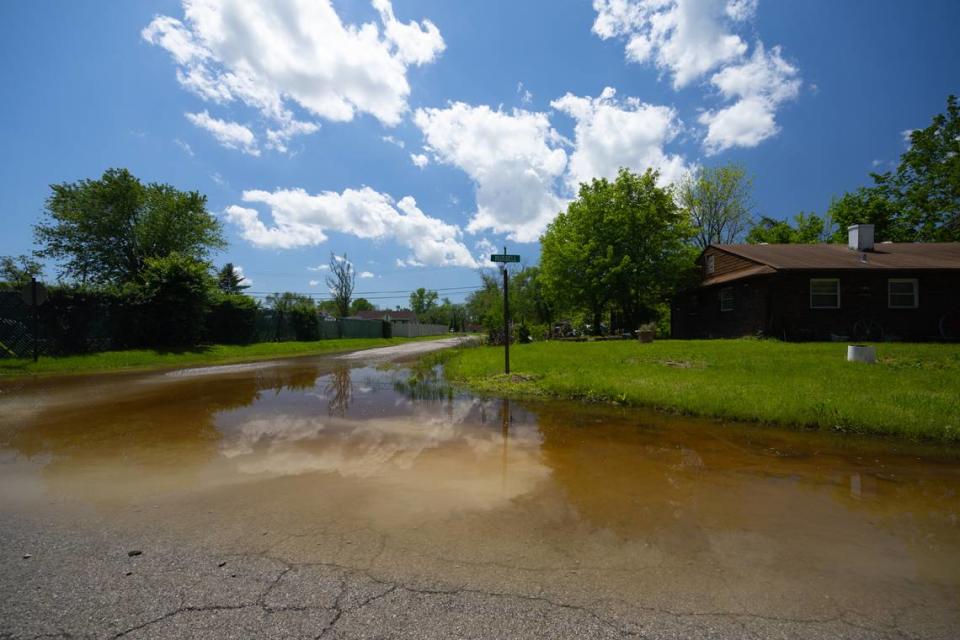Only a fraction of the money sought for Cahokia Heights projects has been spent. Why?
- Oops!Something went wrong.Please try again later.
To date, only 4% of the money sought for projects to help the city of Cahokia Heights address its flooding and sewage crisis has been spent, according to comprehensive project and funding information released by the Environmental Protection Agency this week.
EPA metro-east coordinator Beth Murphy has spent the last several months collecting the information from local, state and federal entities and entering it into a central location: a spreadsheet the EPA is calling the “funding matrix.”
Murphy presented her findings from the task during a virtual press briefing Thursday along with Betsy Nightingale, who will be her successor as metro-east coordinator, and U.S. Rep. Nikki Budzinski.
Budzinski represents Cahokia Heights in Congress and sought the creation of the metro-east coordinator position to help bring more transparency to the investments that have been made and what’s still needed.
Among Murphy’s findings:
The city, HeartLands Conservancy, the U.S. Army Corps of Engineers and the resident group Centreville Citizens for Change have collectively sought or plan to seek $71.9 million to respond to the crisis in Cahokia Heights.
$28.9 million of that money has been obligated, the next step after requesting. This funding is committed to Cahokia Heights projects but not yet available.
$17.7 million has been awarded, the step after obligated. This funding is available for the groups managing the projects to use.
$2.9 million has been spent on Cahokia Heights projects, an indication those projects may be completed.
Over $22 million is still needed for projects.
For decades, deteriorating infrastructure has caused sewage to spill from pipes into streets and homes, a problem made worse by chronic flooding. Local, state and federal officials started working together to find money to fix it after lawsuits and media reports about the effects on residents drew more attention to the issue starting in 2020.
According to the funding matrix, a total of 85 projects in Cahokia Heights are either underway, completed or being developed. The document covers funding starting from fiscal year 2022.
Money has been spent on 22 of the projects. Eleven projects still need funding, including clearing Harding Ditch, a large flooding mitigation project for which the cost hasn’t yet been estimated, according to the EPA.
Harding Ditch is a major stormwater drainage canal that officials from Cahokia Heights and East St. Louis have said needs to be cleaned of sediment that has built up over time, making it more narrow and unable to hold as much water.
In response to reporter questions about the money that hasn’t yet reached the community, Murphy stressed that accessing government funding is a process that involves demonstrating financial capability and a good project plan to the agency that’s going to write the check. The group managing a project could still be gathering and submitting paperwork or waiting for an agency’s decision.
Murphy also noted the large number of projects slated for Cahokia Heights.
“There’s only so many folks to be able to complete all those projects,” she said. “They can’t all be conducted at the same time.”
The EPA hopes the city, Army Corps of Engineers and community groups can use the funding matrix to prioritize the projects, according to Murphy.
In a pre-recorded message, EPA Region 5 Administrator Debra Shore said at the briefing that compiling and releasing the information is also one of the ways the EPA is working to rebuild public trust.
Budzinski described it as an unprecedented level of transparency.
Budzinski, along with her colleagues U.S. Sens. Tammy Duckworth and Dick Durbin, helped obtain some of the funding for Cahokia Heights projects through congressional earmarks.
Each of the lawmakers on Thursday reiterated their concern for residents’ health in statements about the release of the detailed project information.
Last summer, researchers from Washington University in St. Louis and the University of Colorado shared the preliminary findings of their health study in Cahokia Heights with the community. They found more than 40% of adults out of an initial sample of 42 had the same stomach infection from the bacteria Helicobacter pylori, or H. pylori.
The lawmakers have also requested that the Centers for Disease Control and Prevention conduct a public health assessment.
The EPA’s funding matrix will continue to be updated with new information about the status of infrastructure projects and funding. Nightingale said it may happen quarterly but the frequency is still open to evaluation.
Anyone can request a copy of the funding matrix by emailing Nightingale at nightingale.elizabeth@epa.gov.


